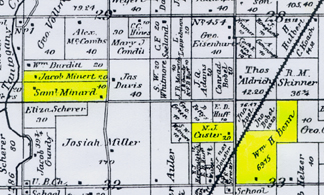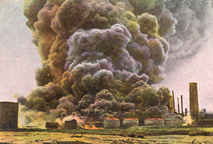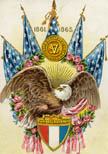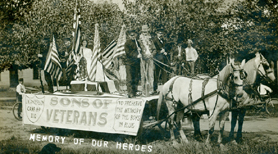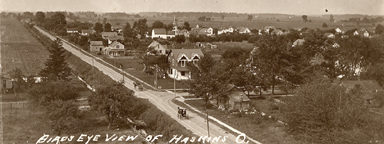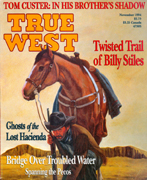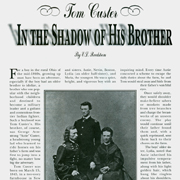
|
Thomas
C. 'Tommy' Custer |
  |
Tommy and Addie |
Thomas C. "Tommy" Custer was born in either 1870 or 1871 near Tontogany, Wood County, OH, the son of Civil War hero Thomas Ward Custer and Rebecca Minerd, who were not married. Tommy's father and uncle, General George Armstrong Custer, were killed together at the infamous Battle of Little Big Horn when Tommy was but a boy. Tommy and his wife are pictured here.
 |
|
Tommy |
A portrait of Tommy is seen here. Custer experts have noted the close facial resemblance between son and father. This is a copy made from an original tintype found in the old photo album of one of Tommy's first cousins.
The story of Tommy and his parents was the subject of our 2002 National Minerd-Miner-Minor Reunion, and a lecture at the 2003 Great Lakes Conference of the Little Big Horn Associates. As well, he is pictured and mentioned in a 2002 biography of his father, Tom Custer: Ride to Glory, by Carl F. Day.
Family lore has been passed down that Tommy's parents were married, but there is no documentation to support this. Rather, research findings show that Tommy's grandparents were neighbors in both Harrison County, Ohio, and later in Wood County, OH. Evidence suggests that while Tommy's father was on military leave, he became involved in an intimate relationship with Rebecca. Sometime between 1866 and 1871, Rebecca gave birth to a son, whom she named "Thomas C. Custer."
The exact year of Tommy's birth is not known. One source, his obituary, implies it was 1866. Another source, the federal census of 1880, suggests it was 1870 or 1871.
Tommy's rare signature |
Perhaps ostracized in her family or the neighborhood, Rebecca did not raise the child, but her parents did so. Indeed, the 1880 census of Washington Township, Wood County, OH shows that in the household of Samuel and Susanna Minerd was "Thomas Custar," their 9-year-old "grandchild." The entry shows that young Tommy had attended school within the year, and that both of his parents had been born in Ohio. Depending on his exact birthdate, he conceivably could have turned 10 later in the year.
There is no evidence that the father ever knew the son, or that the Custers ever acknowledged the boy. While father Tom wrote a will in 1873, in Monroe, MI, he did not name the son, and left everything to a fiancee and to his mother. In Tom's Civil War pension papers, on file at the National Archives in Washington, DC, the boy is not identified in any way.
In 1890, when Tommy's grandmother (Susanna Minerd) gave a deposition in the legal case, Tommy signed the document as a witness.
|
|
|
1880 federal census of Wood County, Ohio, showing Thomas Custar as a "Grandchild" in the Minerd home |
~ The Benn Perspective ~
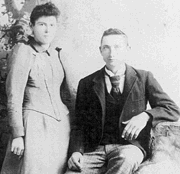 |
|
Tommy and Addie, ca. 1892 |
On Feb. 11, 1892, at the age of 22, Tommy wed his longtime neighbor, 16-year-old Addie Viola Benn, the daughter of William H. and Martha (Brown) Benn. The photo seen here could possibly be their wedding portrait. Their marriage license today is still on file at the Wood County Courthouse in Bowling Green.
The Benns' 40-acre farm was to the east of the Minerd cluster of farms, along the railroad, just 200 feet from where George and Tom Custer's brother, Nevin J. Custer, was living in 1886. At the time, Nevin was an absentee owner, residing in Monroe, but certainly he would have had to have known Tommy and his wife.
William Benn, Addie's father, also was a veteran of the Civil War. He had served with the 144th Ohio Volunteer Infantry, the same regiment as Tommy's cousins Eli and Isaac Van Horn. An examination of Benn's Civil War pension papers in 2003 at the National Archives in Washington, DC are revealing. While they do not make any reference to Tommy as Benn's son in law, they do contain a page with Addie's rare signature as a witness -- "Addie V. Custer."
| Addie's signature as a Custer |
Benn's Civil War files also contain affidavits from a number of longtime neighbors who also would have known all about Tommy's family secrets. These neighbors include the following individuals -- Hester McComb (who claimed in 1897 to have been "well and intimately acquainted" with the Benns for "about 30 years and during that time ... have lived as near neighbor to them and their family..."). Other neighbors circa 1897-1898 were Martin Warner (38 years); John Q. Adams (37 years); Lewis Hoelzer (from boyhood - 25 years); Jacob Danster (38 years); Elizabeth Danster (40 years); I.B. Van Valkenberg (33 years); Christie A. Cummings (35 years); Perkins Garrett (20 years); and Eli F. Mozena (17 years).
|
|
|
The proximity of the Benn, Nevin Custer and Minerd farms is shown in the 1886 Atlas of Wood County, Ohio |
~ Tommy's Working and Social Life ~
 |
|
Smoky oil rig |
Petroleum was discovered in quantity in Wood County in 1885, when Tommy was a teenager. Unfortunately, the newly found oil, while a lucrative product providing many local jobs, "had intractable quality problems that threatened to destroy its value," writes Ron Chernow in his national bestseller, Titan: The Life of John D. Rockefeller Sr. "[Its] high sulfur content corroded machinery and gave off a deadly smell."
It was in this booming environment that Tommy labored in northwest Ohio fields as an "oil operator," said Beers' 1897 book, Commemorative Historical and Biographical Record of Wood County, Ohio. The smoky Wood County oil rig fire seen here in an old photographic postcard is typical of the context in which he would have worked day-in, day-out. According to the Commemorative Record, in the year 1895 alone, there were nearly 1,800 new wells in operation in the county: "[T]he driller was at work day and night, and derricks appeared everywhere..."
Tommy also was a popular member of the John B. Creps Camp, Tontogany, Sons of Veterans No. 61, Division of Ohio (later renamed the Sons of Union Veterans of the Civil War). The S. of V. was a spinoff of the Grand Army of the Republic (GAR) organization, a group advocating for the rights of veterans to vote and to collect pensions. Tommy's membership in the S. of V. is further evidence that his father was an acknowledged veteran of the Civil War, that Tommy knew this fact, and that his community of peers widely accepted this in order for him to gain membership.
|
|
|
Bowling Green-area oilfield scenes with which Tommy would have been familiar -- filling a torpedo with nitro glycerine to shoot into a well (left) and tanks burning out of control |
According to the S. of V. website:
In 1881 the GAR formed the Sons of Veterans of the United States of America (SV) to carry on its traditions and memory long after the GAR had ceased to exist. Membership was open to any man who could prove ancestry to a member of the GAR or to a veteran eligible for membership in the GAR.
|
|
|
The S. of V.'s impressive, fanciful logo circa 1910, and their typical parade float honoring the "Boys in Blue" |
~ Tommy's Untimely Death ~
 |
|
Tontogany's dirt-paved Main Street |
Tommy and Addie were married for only a few short years. They resided in or near Tontogany.
Tontogany's dirt-paved Main Street of that era is seen here in a rare old photographic postcard (published by Dr. A. Eddmon of Tontogany). Note the railroad tracks in the foreground, and the telephone or electrical poles on both the left-hand and right-hand sidewalks.
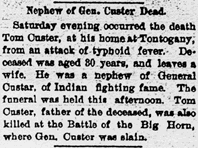 |
|
Wood County Sentinel, Aug. 7, 1896 |
Addie and Tommy suffered a major blow on April 25, 1895 when Addie's father passed away at home. She was to receive an even greater tragedy a year later.
On Aug. 1, 1896, suffering from typhoid fever, Tommy passed away. He was only about 25 years of age. The funeral was held at the local Presbyterian Church, possibly led by Rev. C.L. Herald, who had officiated at the funeral of Addie's father a year earlier. Tommy's remains are believed to have been laid to rest in the Union Hill Cemetery east of Tontogany. While his grave is not marked, he quite likely may have been buried in the Minerd plot beside his beloved grandmother, Susanna Minerd.
Tommy's obituary was published in the Wood County Sentinel, dated Aug. 7, 1896. Of the documents found to date, it is the most compelling evidence of Tommy's lineage.
Six days later, the Sentinel reported: "The funeral of Thomas Custer was held on Monday … Mr. Custer was a very estimable young man with a large circle of friends, who deeply sympathize with his young widow in her sad bereavement."
|
Nephew of Gen. Custer Dead. |
|
Saturday evening occurred the death Tom Custer, at his home at Tontogany, from an attack of typhoid fever. Deceased was aged 30 years, and leaves a wife. He was a nephew of General Custar, of Indian fighting fame. The funeral was held on Monday. Tom Custer, father of the deceased, was also killed at the Battle of the Big Horn, where Gen. Custer was slain. |
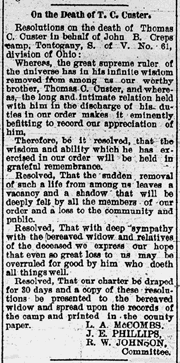 |
| Bowling Green Daily Sentinel, Aug. 7, 1896 |
According to a recent Bowling Green Sentinel-Tribune article, "There is no tombstone or sexton’s record of him, only the wisp of a family memory of his widow visiting the cemetery." The article also says that "No birth or death records have been located… The records might have been misplaced, and also, 'illegitimacy at that time was hidden'…"
Tommy's friends in the S. of V. placed an advertisement in the Aug. 7, 1896 edition of the Bowling Green Daily Sentinel. It was entitled "On the Death of T.C. Custer," and the text contained a resolution of bereavement. The resolution is seen here in full, and was signed by S. of V. members L.A. McCombs, J.E. Phillips and R.W. Johnson.
Unfortunately, they produced no children, and thus have no descendants living today to tell their story.
~ Addie's New Family ~
Addie was devastated by her loss, yet with determination she continued on with her life. Circa April 1899, Addie resided in Haskins, Wood County, and may have held a job in Toledo to generate needed income. In a letter to Tommy's aunt Jemima (Minerd) Burditt, Addie wrote:
I hope I can stand the work and won't get home sick. I feel like my heart weighed a great deal tonight. It's a great deal harder for me to leave than I ever dreamed of. I could burst out crying at one little word. It hurts me so to have them say good by to me. I can't hardly stand it. I hope to be stronger in this affair before long... It will be hard for me to get acquainted with all the strange people but such is life.
The following year, in 1900, Addie married John P. Cain (1866-1949), a native of Oil City, PA, who had moved to Ohio. They resided in Bowling Green and went on to have six children -- Audene McFarland, Helen Hadley, Edith Koch, Ralph Cain, Emerson Cain and Shirley Cain.
Addie and John lived for 3 years at Muskegon and Manistee, MI, and may also have resided in Minnesota for a time. Said the Bowling Green Daily Sentinel-Tribune, "His life's work was spent in the oil fields as a worker and later as a contractor. He worked in the oil fields in Oklahoma, Kentucky and later in Michigan."
In 1903, the Cains were in Bowling Green, where John's brother boarded in their home. Wrote Addie: "...that made two men & 2 [lunch] pails instead of 1 man with baby getting teeth & doing all my own work."
|
|
|
Bird's-eye view of Haskins |
 |
| Addie's obituary, 1933 |
Although after her remarriage Addie was no longer legally related to the Minerds, she remained very fond of the family, especially Tommy's grandfather Samuel Minerd and Tommy's aunt Jemima Burditt. When Jemima passed away in 1914, Addie was named in the obituary as a surviving relative.
Addie especially loved Tommy's grandfather Samuel Minerd, and after his death, she wrote to a relative in 1905:
Oh how many times I wonder how you are and what you do, since Grandpa left you. How lonesome you must be... I did not get to the cemetery as things hindered me. The baby was not well so I could not go. Aunt Pera's drove up after me that morn... Did Grandpa have conscious and did he know every body. I have not heard anything about it... I received the memorial card all right and many thanks for it.
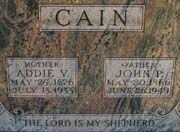 |
|
Union Hill Cemetery, Tontogany |
When Addie died on June 8, 1933, her obituary did not acknowledge her first marriage to Tommy Custer, but did say that:
She was a devout worshiper at her shrine of faith, the First Church of Christ. She was a member of the Ladies Aid and took an active part in its work, being its president at the time of her death. She took an active interest in all church work.... Her spirit of friendliness also found an outlet as a member of the Rebekah Lodge. Always interested in education, she was a member of the Research Club and was a past vice-president of the Parent-Teachers Association of the South Main school.
One of Addie's daughters later recalled for researchers that Addie often brought her children by streetcar to the cemetery. She would tend to family graves, and then quietly walk "up over the hill" for a private meditation. It's believed she was visiting Tommy's grave among those in the old Minerd plot, but this has not been proven.
John outlived Addie by 16 years. He died on June 26, 1949.
Addie and John rest for eternity at Union Hill Cemetery between Tontogany and Bowling Green. They are buried in the same row as her first husband's cousins, Gurdon and Edith (Miner) Keeler. The inscription on their grave marker quotes the 23rd Psalm: "The Lord is my shepherd."
Addie's children preserved the memory of their mother's Custer connection, and passed it down among the generations.
|
|
|
Article in the Bowling Green Sentinel-Tribune |
~ National Expert Brian Pohanka's Views ~
 |
|
Brian Pohanka |
Sadly, the month of June 2005 brought the passing of nationally recognized Civil War expert Brian Pohanka -- who helped inspire the Minerd.com research effort into the Custer question. May he rest in everlasting peace. Pohanka, a historical consultant for such films as Glory and Cold Mountain, and an expert on Gen. George A. Custer, met with the founder in the fall of 2002, at a meeting of the Greater Pittsburgh Civil War Round Table.
Graciously, Pohanka reviewed our research findings regarding Tommy Custer, and in an email, he wrote:
Thank you for sharing that piece on Thomas W. Custer's son... I would say that you have assembled a fascinating article that, to my mind, presents a pretty solid case for Tom Custer having fathered this boy. Like so many such things, all the details can never be fully known, but you are certainly on the right track in the detective work that makes History so fascinating. Excellent work -- fascinating.
|
|
|
Ernest Lisle Reedstrom's article mentioning Tommy and his mother in True West Magazine, November 1994 |
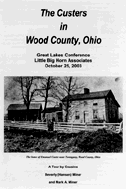 |
| Booklet by Mark A. Miner |
~ Tommy and His Story Take on a National Persona ~
Perhaps the first article to publicly mention Tommy and his Minerd mother was written by noted Custer historian and author Ernest Lisle Reedstrom. Headlined "Tom Custer: In the Shadow of His Brother," the piece was published in the November 1994 edition of the magazine, Old West. A photo of Tommy appeared in the article, from the archives of Bowling Green State University.
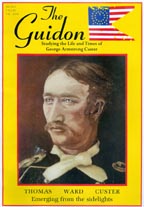 |
| Magazine, 1999 |
In 1999, the publication The Guidon (vol. 3, No. 1), published in Huddersfield, England by Roger Young, devoted an entire edition to Tom, including a cover photo, headlined "Thomas Ward Custer: Emerging from the Sidelights." The 36-page, limited edition softcover issue carried articles such as "Tom Should Have Been the General" by Rosemary Pardoe; "Blown Opportunities" by L.F. Padilla and R.J. Castagnaro; "Tom Custer: Banners of Glory" by Carl Day; "Armstrong ... I've Got My Flag" by Jeff Broome; "Tenting with Tom" excerpts from the Liberty P. Warner papers; "The Last Will and Testament of Thomas Ward Custer" by Carl Day; and "The Final Resting Place of Tom Custer" by Jeff Broome.
The story did not begin to take on a more popular following until it appeared in Carl Day's 2002 book.
In October 2003, the memory of Tommy Custer was honored during a lecture and bus tour conducted by cousins Beverly (Hansen) Miner and Mark A. Miner. The tour visited old Custer-Minerd farms and cemeteries near Bowling Green, OH, for the Little Big Horn Associates' Great Lakes Conference. We published a special booklet, The Custers in Wood County, Ohio, packed with photos and information.
The tour also featured remarks by Steve Alexander (seen at right), the nation's foremost Gen. Custer reenactor and living historian who actually owns and resides in the General's former home in Monroe, MI. The tour was featured in articles in the Toledo Blade, Bowling Green Sentinel and Perrysburg Messenger Journal, and was taped for possible broadcast on HPAC2, the Hastings Public Access Channel 2 in Michigan.
In 2005, Tommy's story was published in the Research Review Magazine of the Little Big Horn Associates, authored by Minerd.com founder Mark Miner. The 11-page feature article was illustrated with more than 20 rare photographs and images. It tells how the community of Tontogany, Ohio harbored the deep Custer family secret "which everyone knew but no one publicly discussed." In the preface, the magazine editor writes that the article reveals "documents, photos, newspaper articles and more in examining the only recently discovered evidence regarding Tom Custer's son... It presents an interesting insight into nineteenth century handling of illegitimate children."
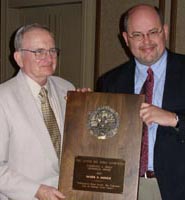 |
| The LBHA's Jack Manion presents
Miner with his award, Richmond, VA, 2006 |
 |
| Steve Alexander |
In July 2006, the Research Review article received the Little Big Horn Associates' Lawrence A. Frost Memorial Award for the best article published in the magazine. The author accepted the award at the annual LBHA conference in Richmond, VA, and posed for the photo at left with John S. Manion, chairman of the editorial review board. The LBHA is a 900-member organization devoted to research, publications and conferences about Gen. Custer, the battle and his family. The award is named in memory of Dr. Frost, a nationally recognized authority who was longtime curator of the Custer collection in the Monroe County Museum in Michigan.
Demonstrating continuing public interest in Tommy's story, he was mentioned in the Pittsburgh Tribune-Review's Sunday "Focus" Magazine cover story about the Custers in its Dec. 3, 2006 edition ("From Ohio to the Little Bighorn: A Small Town Claims Lt. Col. George Armstrong Custer as One of Its Own").
Tommy's tale was told again at the 2007 national conference of the Little Big Horn Associates in North Platte, NE. Author Miner gave a powerpoint presentation to an audience of about 150 Custer enthusiasts. In a published review, in the LBHA Newsletter, editor Steve Arnold writes: "Another presentation tore the lid off 'Tontogany's Deep Secret'... Speaker Mark Miner plowed new ground by raising questions about why the Custer clan refused to acknowledge the boy. The Custer's, he said, were a tight knit family so it seems surprising they would ignore a son of one of its favored members. The only answer he offers is the idea of respect for a tragic family." (Little Big Horn Associates Newsletter, Vol. XLI, No. 7, Sept. 2007)
Click to see a page of more photo images of the Custers.
|
Copyright © 2001-2012, 2019 Mark A. Miner |
|
Brian Pohanka photo by Allison Barash, Greater Pittsburgh Civil War Round Table |

